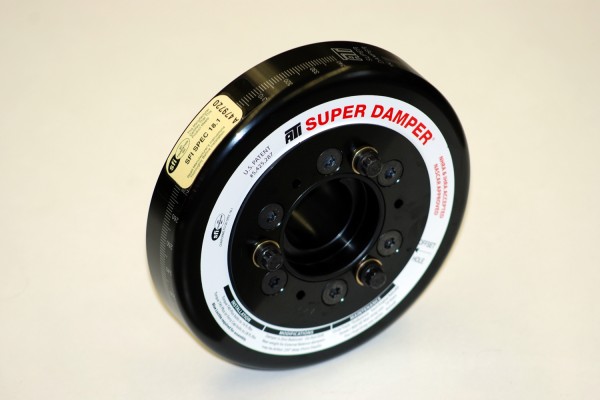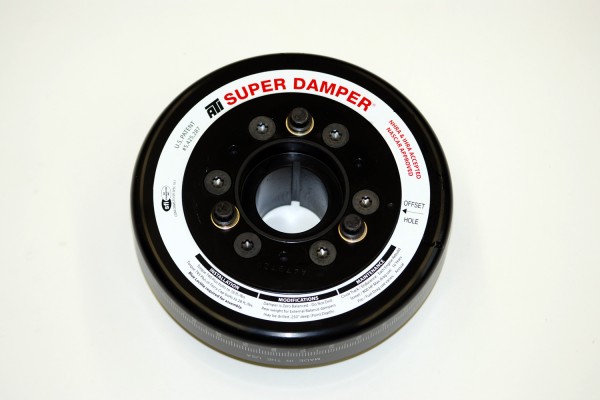Some call it a harmonic balancer.
Others refer to it as a harmonic damper.
Whatever you call it, that big chunk of metal hanging off the crankshaft snout of your engine is essential to your powerplant’s wellbeing and performance. Its job is to absorb harmonics, so from here-on-out we’ll refer to it as a harmonic damper (its only true proper name, we believe).
Why You Need a Harmonic Damper
The crankshaft buried deep inside the engine in your car isn’t a solid, immovable hunk of steel or iron. The crank twists and bends relative to the loads placed upon it by the respective pistons and rods on each throw. General Motor’s research has shown there is considerable crankshaft deflection in a race-prepped engine spinning at 8,000 rpm.
There is also resonance to consider. This occurs when the torque an engine makes on each combustion cycle “syncs” with the crankshaft’s natural vibration frequency. Without a proper harmonic damper to dissipate the torsional vibration caused by resonance and deflection, certain crank failure and other damage will occur, including:
- Worn main bearings
- Misaligned main bearing caps
- Loose connecting rod bolts
- Shortened valve spring life
- Broken oil pump drive shaft
- Stretched or broken timing chain
- Scattered ignition timing
- Loose flywheel/flexplate bolts
- Fractured flywheel
- Difficulty shifting gears with a manual transmission
How Operating Range Factors In
Engines operate in widely varying rpm ranges. This operating range, coupled with the rate at which an engine accelerates, can have a considerable effect upon the harmonic damper required. OEMs design dampers that are “tuned” for an engine’s specific rpm range. For example, a damper for a diesel highway truck with a dozen or more forward gears is tuned for a very narrow rpm range. On the other hand, a Corvette equipped with an LS-series small block and an automatic transmission might operate in a very wide RPM range—say 800 to almost 7,000 rpm.
Katech conducted a harmonic damper test for General Motors several years ago. The test involved the use of four different aftermarket dampers on a 427-cubic-inch small block. From 3,112 to approximately 6,500 rpm, all of the dampers limited crankshaft twist to no more than 0.6 degrees. Above 6,500 rpm, things got interesting. Crankshaft twist increased by a considerable margin with three of the dampers. At 7,893 rpm, one damper allowed a considerable 2.0 degrees of crank twist. The second had 1.7 degrees of twist, and the third had approximately 1.25 degrees of twist. The last damper—made by ATI—allowed just 0.28 degrees of crankshaft twist.
Inside the ATI Damper
OK, so the ATI Super Damper used in the General Motors test really works.
But what makes it tick?
The ATI damper is a significant improvement on the proven elastomer damper configuration. A typical OEM style single-strip elastomer damper has an inertia weight (also called a ring) with a rubber insulator pressed to the crank hub. The inertia ring can move in relation to the hub when the elastomer material wears. As ATI points out: “During the manufacturing process of an OEM damper, it is impossible to maintain the concentricity of the inertia ring to the hub. The ring must be machined after it is pressed to the hub, and then balanced after machining. When it comes loose, imbalance can and will occur.”
Even if the inertia weight doesn’t fly off, this movement often causes the timing marks to be thrown out of whack in relation to the crank keyway. That makes it tough to properly time the engine.
In contrast, the ATI Super Damper employs a combination of O-rings and a unique, full-captured inertia ring to dampen harmful crankshaft vibrations. This configuration allows the damper to actually absorb crankshaft harmonics over a wide rpm range. It is not uncommon to find a Super Damper on race engines exceeding 9,000 rpm.
Elastomer dampers have been given a bad rap since the elastomer material can deteriorate and allow the inertia ring to slide or rotate. ATI solved the deterioration problem by creating a damper with removable elastomer strips. That means a Super Damper can be rebuilt at home or returned to ATI for quick rebuilding. Summit Racing offers a replacement elastomer kit and the special set of tools designed to rebuild the damper.
ATI offers many damper sizes and configurations for small and big block Chevy, Ford, and Mopar as well as AMC, Cadillac, Buick, Oldsmobile, and Pontiac engines. ATI also makes dampers for later model engines such as the GM LT1 and LS, late Mopar Hemis, and various late model Ford engines using serpentine belt drives integral with the damper. ATI also makes lightweight aluminum dampers in two different diameters for specific engines, plus lightweight race-only dampers for extreme rpm applications.
The performance benefits of using the proper harmonic damper are considerable. A properly functioning damper stabilizes camshaft and ignition timing. A reduction in twist at the end of the crank also stabilizes the valvetrain. The result is more power and longer engine life.









VERY GOOD I ALWAYS LEARN SOMETHING NEW,THANK YOU.
[…] Read More […]
is the balancer suppose to go all the way back to the gear drive
What are the pros vs cons and application recommendations when comparing an ATI standard steel hub 6.325″ to their 7″ ???
Do they wear out…..
Yes. They can be rebuilt for $75
Do you have a marine application for a 350 vortec chevy that operates continuously at 4800 rpm under load
Not sure you might need to contact ATI
[…] Harmonic dampers are incredibly important yet often overlooked. We visited the world of harmonic dampers six years ago. (Read: Harmonics 101: Understanding Harmonic Dampers.) […]
Check out ATI other offerings for jetskis
So, it there a “magic formula” for getting the right one? I have;
SBC, 388 (started life as an L31, truck Vortec)
Aluminum heads
Comp extreme energy hydraulic roller, 224/230
10.25:1
Scat crank
I get a vibration about 4200 to 4500, then it “goes away”. I’ve only run the motor up to about 5300.
Could this be in part to the damper?